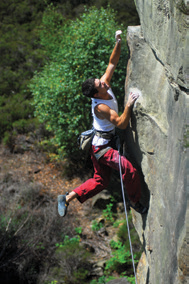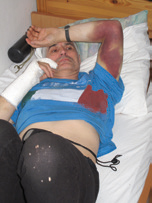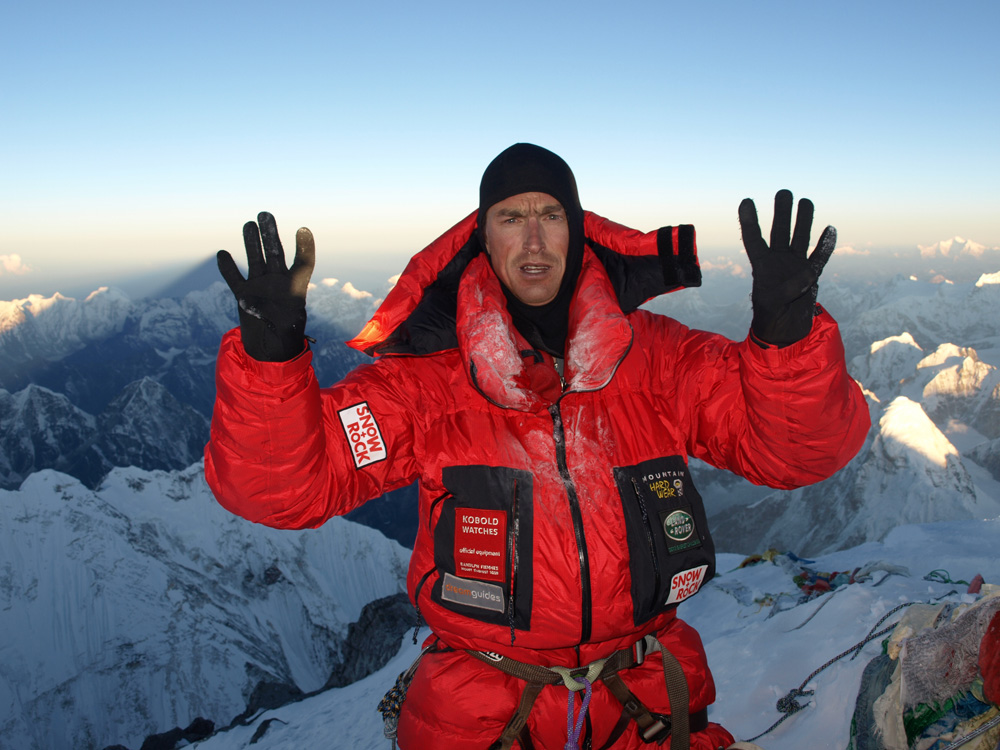What goes up sometimes comes back down: accident and injury can strike at any time, but what does it take to get back on top?
In the run up to our third Climbing Injury Symposium we catch up with nine climbers to find out about the setbacks they've encountered, and how they recovered from them:

Fran Brown, paraclimber
Fran, an incomplete tetraplegic following a spinal-cord injury in 2006 while working as a lighting engineer, became World Paraclimbing Champion in 2012.
“It took me two years to get back into climbing after my spinal-cord injury. I was worried about being accepted in the climbing environment and how I could logistically climb again. Not wishing to let my injury define me gave me the mental strength to ignore all the people who stare or make unhelpful comments about my new way of climbing. Ultimately, my experience has made me a stronger and more focused climber.”

Jordan Buys, grit climber
Jordan Buys took fall putting up an E8 in a Lancashire Quarry, breaking his ankle. He returned to finish the route.
“Breaking my leg seemed to be the most inconvenient event of my life. I felt like a caged lion, and I channelled that energy into whatever training I could do and came out stronger than before. Within a week of my cast being removed, I climbed 8a; a week later, I was back to 8b. I made short work of the new route that had broken my leg, a bold E8 which I called Boomerang.”

Nick Colton, mountaineer
Nick nearly died when an ice pillar collapsed. He’s gone on to explore the Himalaya.
“I was leading the fifth pitch of an ice route. As I approached the top, there was a huge cracking sound and the pillar collapsed with me on it. I fell 45 foot and thought I was going to die. When I came round I was full of cuts and bruises, but the worse injury was my back: I’d crushed my L1 vertebrate. I went to the Himalayas four months after the fall and came third in the Veterans category of the British Lead Climbing Competition eight months afterwards. It’s not ideal, but it’s a good excuse not to carry a heavy sack.”
Kenton Cool, Everest mountaineer
Sixteen years ago, Kenton was left in a wheelchair after breaking both his ankles falling off a slate route. Told that he would never be able to walk without a stick, he has since become an international mountain guide and climbed Everest 11 times.
“A line from a great man was my mantra: success is the ability to go from one failure to another with no loss of enthusiasm. After so many setbacks – my ankles, getting funding for trips – it just seems so very true.”

Shauna Coxsey, boulderer
Shauna Coxsey successfully defended her British Bouldering Champion title in July 2012. A few weeks later she broke her leg in Switzerland, yet still managed to win the British Lead Climbing Championships the following October.
“I was lucky that I could still train hard. I had to stay away from bouldering for a while but I was really psyched to get back into roped climbing. Everyone deals with things differently but, at the end of the day, you can’t change what’s happened. There isn’t much point in being angry. If you can stay positive and make the most of a bad situation then you’ll come back stronger.”
Alan Hinkes, mountaineer
In 2005, Alan Hinkes became the first Briton to climb all fourteen of the world’s 8,000-metre peaks. On the final peak, Kangchenjunga, he survived a panic attack just below the summit.
“Alone in the dark at 8pm at 8,500m, after a solo summit push in a snowstorm, I had a panic attack. I started hyperventilating and shaking like a leaf. Somehow I mentally pulled myself together and focussed on the technical tasks of getting down: facing in, climbing down and not falling off, abseiling and finding the route. The fear and anxiety then fell away and the experience was pleasurable, even though I knew that I was probably going to die. Massive amounts of snow were falling and I thought that I’d probably be avalanched. I pushed the anxiety to the back of my mind and got on with trying to survive.”
Neil Mawson, trad climber
Neil Mawson took a ground fall from Meshuga (E9) at Black Rocks in 2005. He reinvented himself as a sport climber.
“Going climbing again wasn’t an issue for me – I love climbing – but going back to try Meshuga was scary. I went back a few times to try it again and every time I could top rope it easily but just couldn’t commit to going on the lead again. Over the next few years, I got into sport climbing much more and did very little traditional climbing. It wasn’t a conscious decision but, looking back on things, it was probably prompted by my fall.”
Andy Parkin: artist and alpinist
In 1984, Andy Parkin fell in the Swiss Alps during his mountain-guide training. His life hanging in the balance, his family flew to his bedside, yet he defied the odds and survived. Unable to climb afterwards, he rekindled his love of painting. However, unexpectedly, and despite permanent disabilities, he rediscovered his ability for cutting-edge climbing and won the Piolet d’Or in 1994 for an epic climb in Patagonia.
“After surviving an accident, and particularly if one is handicapped by it, one of the biggest problems is overcoming the depression. Suddenly we are no longer young, fit, strong, without a care in the world but aged, dependent, lost, without much of a future. The thought of going on through life as an invalid is soul destroying. I’ve seen amazing examples of courage in the hospitals, things that help motivate one into clinging on to some sort of concept of a future. I have also seen people simply give up and die as they lack the will to fight back and regain the sense of dignity that’s so precious to the human spirit. I was fortunate in the sense that I already painted and had a means of expression. I put all my energy into it and finished up recreating a lifestyle that took me back to climbing, the thing I loved above all. Now, I have the two and feel richer for it.”
Audrey Seguy, climber
Audrey runs the Castle Climbing Centre in London. Blowing ligaments in both her knees didn’t stop her climbing.
“I’ve had lots of setbacks. Memorably, I’ve blown ligaments in both my knees (2004 and 2009), had operations on both and now have two pins in each knee. A few things did help: do everything you can to get better; remember that climbing is a lifelong activity, so even a long break of one year is small beans; and focus on other aspects of your life. Climbing tends to take over your life and injury time was a good time to expand my horizons. The key theme to all these is that they all give you something positive to think about so you’re not wallowing in self-pity.”
Learn to avoid injury at the 2014 BMC Climbing Injury Symposium
Ok, so we can't promise that, but coming along to our Climbing Injury Symposium will give you better than average odds of avoiding injury by teaching you about the causes of injuries, and information on recovery in case the worse does happen, with up to date evidence-based talks and workshops on climbing injuries in adult and young climbers; given by medical surgeons and doctors (specialising in hands, feet and shoulders) and specialists in radiology, podiatry, physiotherapy and nutrition.
Perfect for doctors, surgeons, allied health professionals, climbing coaches, sport & exercise specialists, climbers and parents of dedicated young climbers alike.
« Back